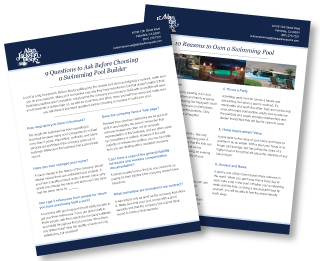You may think that putting in a custom pool simply means showing a designer a few photos of what you like or telling them you’d like a kidney-shaped pool. While pool designers handle most of the design decisions, you’ll choose your pool shape, depth, supplementary items like a waterfall or slide and the pool material.
Differences in Materials
Not all pool walls are the same. The common materials for pool walls include: cast-in-place concrete, gunite, polymer, shotcrete and steel. Some of these choices perform better in salt air environments, wet soil or shifting soils. While you won’t see the walls once the pool gets finished since wall foam and liner will cover them, they form the foundation of your swimming pool. Their performance affects how your pool will last.
Cast-in-place Concrete Pool Walls
While cast-in-place concrete remains the most common concrete, it’s the least appropriate for swimming pools. Gunite and shotcrete provide sturdier choices. It can provide a waterproof design, but when forms are removed during vertical wall construction, it can result in pits which the installers must fill and smooth with compatible materials. The installer must then treat the wall with plaster or paint. It also results in numerous separation joints that occur between the sections of the pool. For pool floors though, it results in a uniform pour and set. It makes it harder to form curves or other shapes besides straight rectangles. It costs more than gunite or shotcrete.
Gunite Pool Walls
Gunite, a different kind of concrete, gets pneumatically applied to the construction surface. It uses more cement and less water than cast-in-place concrete or shotcrete. This produces a dry mix that lets installers easily create vertical walls. Its lower water volume results in the need for fewer joints. It provides the greatest strength of the concrete types and the most watertight concrete pool.
Polymer Pool Walls
Polymer, also called resin, walls use a non–corrosive structural polymer resin material that weighs less than other materials, but remains stable. Their use allows for quicker pool construction. They combine well with aluminum concrete bullnose coping. The compact support structure of polymer requires about one foot less over-dig. Using this type does require more panels to connect benches or steps or make a curved radius. It requires gravel for backfill and the pool needs filling with water before backfilling. Polymer performs better than steel in wet soil and in salty sea air.
Shotcrete Pool Walls
Shotcrete, a third type of concrete, allows for free-form application horizontally or vertically. It provides watertight structures. You’ve probably driven through tunnels made of shotcrete. Like gunite, it uses a lower water content. It results in a stronger pool wall than cast-in-place concrete. Similar to gunite, it produces fewer joints between pool wall sections. It does produce a rougher finish, but this gets covered with pool plaster or epoxy pool paint.
Steel Pool Walls
Galvanized steel contains a rust retardant on each panel that helps prevent corrosion. Steel walls provide greater strength than polymer ones. They also use adjustable turnbuckle braces allowing the installer to adjust the wall in or out making it easier to plumb and level. Using steel increases your options with respect to steps and benches in the pool design. They also deal with temperature changes well and shifting soils, a benefit in Southern California.
Steel walls make it easier to add a cantilever coping and a brick or concrete pool deck. During construction, the crew won’t need water to backfill the walls. It also allows the use of the excavated dirt as backfill. Steel pool walls also allow greater flexibility with temperature changes and shifting soils. Installing wall foam over steel walls further reduces any rust possibility.
Contact us at Alan Jackson Pools Inc. to determine which pool material works best for your dream design and home location. We can help you choose the best material to add value to your High Desert Area home in Lancaster, Palmdale and Santa Clarita.


